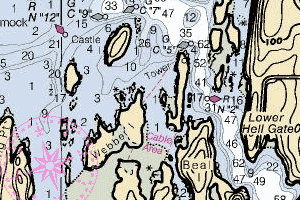 On roads, there are defined lanes, traffic lights, and speed limits. The sea, in comparison, might seem like a free-for-all. However, thanks to the Navigational Rules of the Road, it isn’t.
On roads, there are defined lanes, traffic lights, and speed limits. The sea, in comparison, might seem like a free-for-all. However, thanks to the Navigational Rules of the Road, it isn’t.
This document summarizes the aspects of the Rules most important for kayakers. Some rules that have little relevance to kayakers are not mentioned. If you are interested, you can read the complete rules or the definitions of terms. As always, if you have any questions, come talk to us — stop by our Paddling Store or e-mail us!
We have often heard paddlers assert, incorrectly, that they have the “right of way” over all other vessels. The Navigation Rules do not give any vessel the right of way. Instead, depending on the circumstances, certain vessels within sight of each other are required to keep out of the way of others. Read on to learn more!
Part A — General Rules
Rule 1: These Rules Apply to Everyone!
These rules apply to all vessels (your kayak is a vessel) and watercraft upon the high seas and connected navigable waters.
Rule 2: Your Responsibility as a Vessel
All vessels are expected to act and respond in accordance with the “ordinary practice of seamen.” This phrase is interpreted broadly, so make sure you, at a minimum, have a chart, compass, tide table, recent marine weather forecast, and the skills and equipment necessary to paddle in that area under those weather conditions.
Navigation Basics — An understanding of basic navigation is required by Rule 2. Our two-hour Navigation Class will introduce the basics of navigation, from use of a chart and compass, to reading tide tables, to trip planning.
Seamen must give due regard to all dangers of navigation and collision and to any special circumstances, including the limitations of the vessels involved. If necessary, you are allowed to break certain Rules to avoid immediate danger.
When you are in any doubt as to whether a dangerous situation exists, assume that it does exist and act accordingly!
Part B1 — Conduct of Vessels in Any and All Conditions
Rule 5: Always Keep a Look-Out
All vessels must constantly maintain a proper look-out by sight and hearing to make a full appraisal of the situation and of the risk of collision. Know what’s going on around you!
Rule 7: Determining Risk of Collision
A risk of collision exists if the compass bearing to an approaching vessel does not appreciably change over time. For example, if that powerboat is still at 2 o’clock, relative to your heading, after a minute of paddling, there’s a real chance you’ll run into it if you maintain your course.
Even when an appreciable bearing change is evident, a risk of collision still may exist if the approaching vessel is very large or at close range.
If there is any doubt, act as if a risk of collision exists.
Rule 8: Take Action to Avoid Collision
If a risk of collision exists, take early and significant action to avoid a collision. Continue monitoring the situation until the other vessel is safely past and clear.
Any alteration of course and/or speed to avoid collision should be large enough to be readily apparent to the other vessel and to give plenty of sea room for safe passage. A succession of small alterations of course and/or speed should be avoided.
Rule 9: Narrow Channels
Any vessel proceeding along a narrow channel or fairway shall keep as far right as is safe and practicable. For kayaks, who can travel in very shallow water, this usually means outside the narrow channel as long as this option is not dangerous.
A kayak shall not impede the passage of a vessel which can safely navigate only within a narrow channel or fairway, or which is constrained by her draft in any other way. Take early action to get out of the way.
Do not cross a narrow passage or fairway if such crossing impedes a vessel which can safely navigate only in the channel.
If you are paddling in a narrow channel and cannot see a possible approaching vessel due to a bend or obstruction, sound one prolonged blast. An approaching vessel should respond with a similar prolonged blast. Read more about sound signals below.
Rule 10: Traffic Separation Zones
Kayakers should never travel along or between designated traffic separation lanes, usually encountered in major harbors and clearly indicated on the chart.
Kayakers should avoid crossing these traffic lanes, if possible, but if required to do so should cross at right angles to the traffic flow as quickly as possible.
Part B2 — Conduct of Vessels in Sight of One Another
Rule 13: Overtaking Situations
When being overtaken from behind, a kayaker should, if possible, maintain course and speed. It is the responsibility of the overtaking vessel to keep out of the way of the vessel being overtaken.
This Rule does not exempt kayakers from Rule 9 when in a narrow channel, nor should it prevent paddlers in danger from acting to save themselves (see Rule 2b).
The overtaking vessel may indicate her intention by the following signals on her whistle (read more about sound signals below).
one short blast = “I am altering my course to the right and intend to leave you on my left side.”
two short blasts = “I am altering my course to the left and intend to leave you on my right side.”
Part B3 — Conduct of Vessels in Restricted Visibility
When navigating in or near an area of restricted visibility, kayaks should sound a fog signal of one prolonged blast on their whistle at least every two minutes.
When navigating in or near an area of restricted visibility, if a fog signal is heard that might represent a risk of collision, stop forward progress, immediately sound one prolonged blast on your whistle, and proceed with extreme caution until danger of collision is over.
Read more about sound signals, including a description of the fog signals to expect from other vessels, below.
Part C — Lights
Lights must be shown from sunset to sunrise and when visibility is restricted.
Kayaks must, at a minimum, carry a white flashlight which can be shown toward an approaching vessel in sufficient time to prevent collision. Therefore, you must have it at hand and not stowed in a hatch.
Alternatively, kayakers can display a constant white sternlight and constant red/green sidelights. You must not show one or the other.
Never use any strobe light to indicate your position while underway.
Part D — Sound & Distress Signals
Rules 32 & 33: Definitions and Equipment for Sound Signals
A kayak must carry a whistle capable of producing sound signals audible at 1/2 mile under calm conditions.
A “short blast” means a sound signal lasting about one second.
A “prolonged blast” means a sound signal lasting about four to six seconds.
The “danger signal” means at least five short and rapid blasts.
Rule 34: Maneuvering and Warning Signals
When vessels are in sight of one another, a vessel underway shall indicate maneuvers by the following whistle signals:
- one short blast means “I am altering my course to the right and intend to leave you on my left side”
- two short blasts means “I am altering my course to the left and intend to leave you on my right side”.
If the other vessel agrees, they should respond with the same signal and act accordingly.
If, however, the proposed maneuver is potentially unsafe, the other vessel should sound the danger signal (at least five short and rapid blasts on the whistle) and each vessel shall take appropriate precautionary action until a safe agreement is made.
If you are paddling in a narrow channel and cannot see a possible approaching vessel due to a bend or obstruction, sound one prolonged blast. An approaching vessel should respond with a similar prolonged blast.
Rule 35: Sound Signals in Restricted Visibility
When operating in or near an area of restricted visibility, whether by day or night, the following signals shall be sounded at least every two minutes:
- Power-driven vessel making way through the water: one prolonged blast.
- A vessel constrained by her draft or restricted in her ability to maneuver, a sailing vessel, a vessel engaged in commercial fishing, or a vessel engaged in towing or pushing another vessel: one prolonged followed by two short blasts.
- Kayak: any whistle signal (we suggest one prolonged blast).
Rule 36: Signals to Attract Attention
If necessary to attract the attention of another vessel, any vessel may make light or sound signals that cannot be mistaken for any signal authorized elsewhere in the Rules, or may direct her searchlight in the direction of the danger.
Rule 37: Distress Signals
When in distress and in need of assistance, a vessel should use the signals described here.
All vessels in U.S. waters are required to carry distress signals when operating between sunset and sunrise, including kayaks.
Kayakers should know these distress signals so they know when they might need to assist others or call for help.
COLREGS Demarcation Lines
COLREGS Demarcation Lines delineate those waters under International Rules (International Regulations for Preventing Collisions at Sea, 1972) from those waters under Inland Navigation Rules. In general, small bays and tidal rivers are considered “inland.”
For a detailed description of the differences between Inland and International Rules, click here.
We have not discussed these differences here because, in general, the differences are minor and we wish to reduce confusion.
COLREGS lines are indicated on your chart, but you can also view a complete list of COLREGS lines online.





